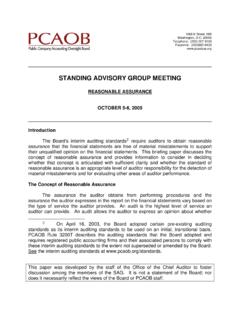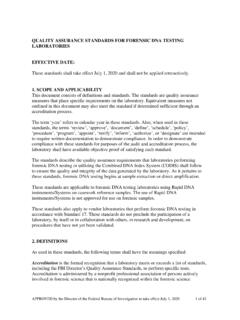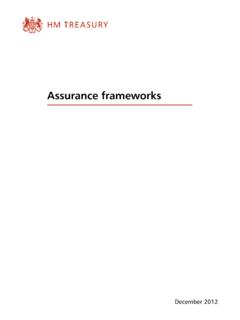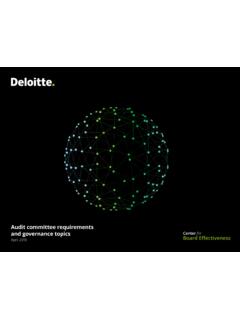Transcription of Audit and Risk Assurance Committee handbook
1 Audit and risk Assurance Committee handbookMarch 2016 Audit and risk Assurance Committee handbookMarch 2016 Crown copyright 2016 This publication is licensed under the terms of the Open Government Licence except where otherwise stated. To view this licence, visit or write to the Information Policy Team, The National Archives, Kew, London TW9 4DU, or email: Where we have identified any third party copyright information you will need to obtain permission from the copyright holders publication is available at Any enquiries regarding this publication should be sent to us at PU1934 1 Contents Page Foreword 3 Chapter 1 Introduction 5 Chapter 2 Good practice principles for Audit and Risk Assurance committees 7 Chapter 3 Membership, independence, objectivity and understanding 9 Chapter 4 Skills 11 Chapter 5 The role and scope of the Committee 13 Chapter 6 Communication and reporting 19 Annex A The role of the Chair: good practice 21 Annex B Committee support.
2 Good practice 23 Annex C Model Letter of Appointment 25 Annex D Example terms of reference 27 Annex E Example core work programme 31 Annex F Key questions for an Audit Committee to ask 33 Annex G Competency framework 37 Annex H Whistleblowing: guidance 39 Annex I Cyber Security: guidance 41 2 3 Foreword Under the Corporate Governance Code in Central Government, Boards are tasked with setting the organisation s risk appetite and ensuring that the framework of governance, risk management and control is in place to manage risk within this. The Audit and Risk Assurance Committee plays a crucial role in supporting the Board to meet these obligations.
3 The role is a challenging one and needs strong, independent members with an appropriate range of skills and experience. It will benefit from a strong collaborative relationship with the organisation to ensure that the Committee gets the support and information that it needs. The Committee will also need to act as the conscience of the organisation and to provide insight and strong constructive challenge where required, such as on risks arising from fiscal and resource constraints, new service delivery models, information flows on risk and control and the agility of the organisation to respond to emerging risks. Whilst much of the content of this document focuses on government departments, it is equally applicable to Executive Agencies, Non-Departmental Public Bodies and other Arm s Length Bodies.
4 Chris Wobschall Deputy Head of Government Internal Audit 5 1 Introduction The Treasury guidance Corporate governance in central government departments: Code of good practice 2011 (thereafter referred to as the Code ) Principle provides that: The board should ensure that there are effective arrangements for governance, risk management and internal control for the whole departmental family. Advice about and scrutiny of key risks is a matter for the board, not a Committee . The board should be supported by: an Audit and Risk Assurance Committee chaired by a suitably experienced non executive board member (NEBM) an internal Audit service operating to Public Sector Internal Audit Standards; and sponsor teams of the department s key arm s length bodies (ALBs) On Audit and Risk Assurance committees , this principle is supported by six supporting provisions in the Code.
5 The board and accounting officer should be supported by an Audit and Risk Assurance Committee advising on key risk is a role for the board. The Audit and Risk Assurance Committee should support the board in this role an Audit and Risk Assurance Committee should not have any executive responsibilities or be charged with making or endorsing any decision the board should ensure that there is adequate support for the Audit and Risk Assurance Committee the Audit and Risk Assurance Committee should lead the assessment of the annual Governance Statement for the board; and the terms of reference of the Audit and Risk Assurance Committee should be made available publicly The Code states In addition to central government departments, the principles in the Code generally hold across other parts of central government, including departments arm s length bodies (ALBs) and non ministerial departments.
6 Arrangements for ALBs may depend on statute. Generally, ministers do not chair ALBs, or non-ministerial departments where statute sets out the applicable governance . This means that Audit and Risk Assurance committees should be established in all departments, Executive Agencies, executive Non-Departmental Public Bodies and other ALBs. Guidance to the Code suggests that the Audit and Risk Assurance Committee might be constituted as two separate committees : an Audit Committee , with a focus on Assurance arrangements over: governance, financial reporting, annual report and accounts, including the governance statement (including areas formerly covered by the statement on internal control).
7 And a risk Assurance Committee , with a focus on ensuring there is an adequate and effective risk management and Assurance framework in place 6 This separation of responsibilities has historically been mainly adopted by banks and financial institutions in response to the recommendations of the Walker Review. In government, all aspects would usually be covered by one Committee , unless the anticipated workload or complexity of the business is such that one Committee would not be able to provide sufficient attention. In such a case, some non executive responsibilities in relation to risk might be more appropriately managed by a risk Assurance Committee . Such a Committee would typically focus on ensuring that the organisation is delivering its services in line with its risk appetite/tolerance and that the risk strategy is appropriately attuned to anticipated external conditions.
8 It should be noted that the remit for any such Committee should be clear and distinct from executive risk management committees that may already exist in some organisations. The rest of this handbook assumes that a single Committee will be established (see Annex C for an example Terms of Reference). The Code requires that the Audit and Risk Assurance Committee should report annually on its work and how it has discharged its responsibilities in accordance with this handbook . Any significant non-compliance with the five good practice principles of this handbook (summarised in Chapter 2), taking account of the supporting good practice guidance, should be explained and reported in the Governance Statement.
9 Other non-compliance may also be reported. 7 2 Good practice principles for Audit and Risk Assurance committees This handbook sets out five good practice principles for the Audit and Risk Assurance Committee in central government. These are summarised below and each principle is then further explained in the following chapters. Each principle is of equal importance. Principle 1: Membership, independence, objectivity and understanding The Audit and Risk Assurance Committee should be independent and objective; in addition, each member should have a good understanding of the objectives and priorities of the organisation and of their role as an Audit and Risk Assurance Committee member.
10 Principle 2: Skills The Audit and Risk Assurance Committee should corporately own an appropriate skills mix to allow it to carry out its overall function. Principle 3: The role of the Audit and Risk Assurance Committee The Audit and Risk Assurance Committee should support the Board and Accounting Officer by reviewing the comprehensiveness and reliability of assurances on governance, risk management, the control environment and the integrity of financial statements and the annual report. Principle 4: Scope of work The scope of the Audit and Risk Assurance Committee work should be defined in its terms of reference, and encompass all the Assurance needs of the Board and Accounting Officer.

















